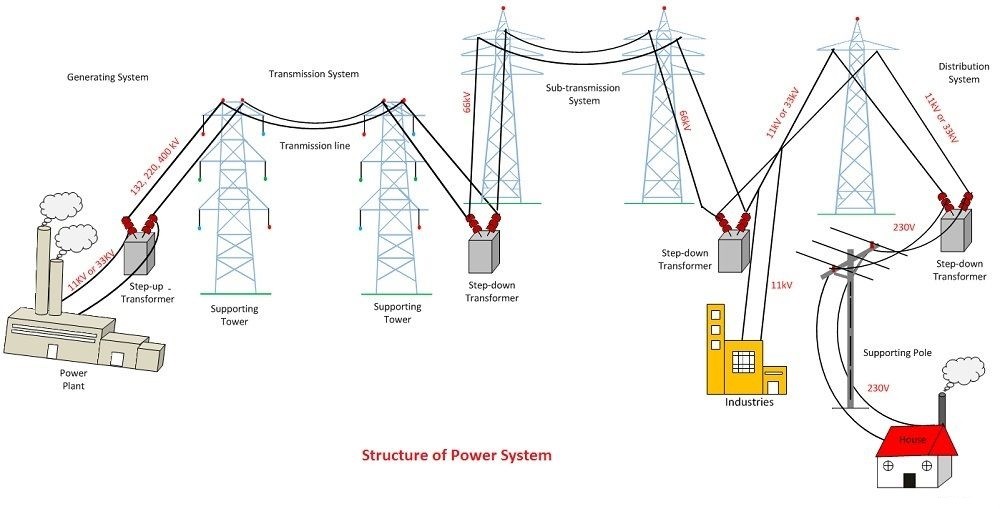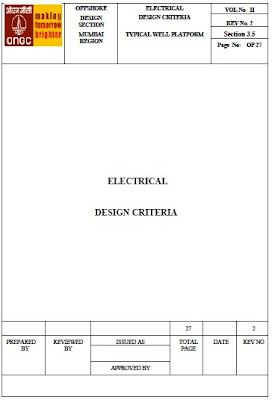
Definitions of Design Criteria
criteria that designers should meet in designing some system or device; “the job specifications summarized the design criteria” ;
- “Design Criteria” are the benchmarks (criteria) against which a design will be measured to deem it successful or failed
- Design Criteria is a document to record the Consultant’s understanding of the project’s design requirements
Objectives of electrical design criteria
The electrical design criteria is a document that:
- State design decisions throughout the design process.
- List any special features and alternatives that were considered.
- Provide a written narrative accurately addressing the electrical and telecommunication design.
- Describe the design approach to all electrical systems.
- Include the method used for sizing conductors, conduit, protective devices, and other equipment.
- When tables from industry standards are used in the design, it indicates the title, source, and date of the document.
- Include a complete list of all design standards and references used for the design.
How to write Electrical Design Criteria?
A standard electrical design criteria Include the information in the following sub-paragraphs as a minimum.
1- Introduction
1.1 Scope : Indicate the objective of design criteria.
Example: This document summarizes the codes, standards, criteria, and practices that will be generally used in the design and construction of electrical engineering systems for the Project.
1.2 Project description: Introduce a short summary for the project.
Example: the project is a high-rise office building with shopping arcade, it has 10-story building (12 floors) with a floor area of approx. 25 m x 60 m. There is a car park for customers in front of the building, the access way to the parking garage (levels -1 to -3 for employees) and a fountain (80 m x 20 m). Real floor area approx. 1350 m2 (14 levels + technical equipment on roof level). Floor heights of levels 00 to +10: 4 m, levels -1 to -3: 3 m.
2- General Conditions
Indicate Environmental and topography conditions at the project area, all equipment shall be suitable for operation at these conditions.
Example:
Design Noise level: NC 60-65 Sound absorbent material in rafters.
Temperature (max/min): 75 F ± 5 degree F
Humidity (max/min): 50% (± 10%)
3- Definitions and Abbreviations
List the definitions of all terms and Abbreviations hat will be used throughout the design criteria document.
Example:
| Abbreviations | Term |
| DC | Direct Current |
| LV | Low Voltage |
| IPXX | Ingress Protection |
| MCB | Miniature Circuit Breaker |
| MCCB | Moulded Case Circuit Breaker |
4- Codes & standards
List all codes and standards that will be used in design process of the project. Example:
A listing of the general codes and industry standards to be used in design and construction follows:
- The American Bearing Manufacturers Association (ABMA)
- American National Standards Institute (ANSI)
- American Society for Testing and Materials (ASTM)
- Insulated Cable Engineers Association (ICEA)
- Institute of Electrical and Electronics Engineers (IEEE)
5- Primary Power Distribution Systems.
5.1 incoming main Power Source :
- Identify the location of the point of connection into the existing primary system.
- Standards of Design :Describe pertinent standards of design, such as voltage drop, and equipment ratings.
- Address the characteristics of this primary system, including:
- voltage designation and levels: Provide basis for selection of primary and secondary voltages.
- Number of phases,
- available fault current,
- the circuit grounding classifications (ungrounded, uni-grounded, resistance grounded, or multi-grounded).
- Address the adequacy of the primary system; if inadequate, state measures proposed to correct the inadequacy.
- System Maintainability: Design the system in a manner that facilitates periodic maintenance of the equipment.
5.2 Estimated Electrical Project Load
Provide an estimate of total connected load (kVA) and the resulting demand load (kVA), transformer size, and service size.
5.3 Address the characteristics of Main Service Equipment (MV switch gear, Transformers substations, metering).
5.4 Distribution methods address the method of power distribution to be one of the following:
- Underground Distribution
- Overhead Distribution
- Bus ducts
5.5 ConductorsInclude conductor size, type, number of conductors, insulation voltage rating, and insulation level.
6- Other Exterior Systems
6.1 Standards of Design Describe pertinent standards of design, such as voltage drop and equipment ratings.
6.2 Alternate Energy Sources
Describe alternate energy systems such as engine-generator sets, photovoltaic power systems, wind turbines, and fuel cells.
6.3 Telecommunications (including voice, video and data) System Identify point of connection into base system. Describe modifications, if required, to existing base system.
6.4 Special Systems:
- Identify any special systems, such as Electronic Security Systems (ESS) or Cable Television (CATV).
- Describe how and where the facility will connect to the basewide Mass Notification System.
6.5 Exterior Lighting Systems Describe types of luminaires and illuminance values.
6.6 ConductorsInclude conductor type and number of conductors.
7- Interior Distribution Systems
7.1 Standards of Design
Describe the proposed standards of design, such as voltage drop, illuminance values, type of light sources, and energy conserving features.
7.2 Describe the electrical systems including the following:
lighting systems; Describe types of luminaires and illuminance values;
- emergency lighting;
- wiring devices;
- distribution equipments (switchgear, switchboards, panels, Motor control centers);
- motors and controllers;
- Power Management;
- Harmonic Distortion And Power Factor,
- overcurrent protection devices,
- disconnecting means,
- grounding systems,
- lightning protection system;
- telecommunications system;
- other systems such as television;
- physical and electronic security features such as ESS, access control.
7.3 Wiring Methods
Indicate the type of wiring method, such as rigid conduit, electrical metallic tubing, cable tray, nonmetallic sheathed cable, and where proposed to use.
7.4 Conductors
Indicate the type of conductors and insulation material such as CU, AL, THW, XHHW, and where proposed to use.
7.5 Special Systems
- Describe the proposed type of systems.
- Indicate each system’s function and the interrelationships between systems, when applicable.
- Identify government-furnished equipment, if any.
- Identify special security requirements.
- Identify special physical security requirements.
Special systems include such systems as:
- Master Clock system
- Fire alarm system
- CATV,
- Closed Circuit Television (CCTV),
- Intercom,
- Sound,
- Nurse Call,
- Security,
- Uninterruptible Power Supplies (UPS).
- Other systems as per project needs.
7.6 Telecommunications Systems
- Identify space required for telecommunication equipment, and size of incoming duct/conduit.
- Include documentation concerning telecommunications room sizes, to accommodate interface equipment provisions for multi-use systems (i.e. special use systems, such as voice, video, and data).
7.7 Instrumentation and Controls
Coordinate all interfaces with instrumentation and control systems provided by other disciplines, and provide required connections, either empty conduits or power wiring as required.
- Normally, the designer for the discipline that is responsible for the process (such as electrical, mechanical, or civil) is also responsible for the instrumentation and controls design of that system.
Notes for Electrical Design Criteria:
Update the design criteria for each stage to accurately show the current state of the design.
Free Download


